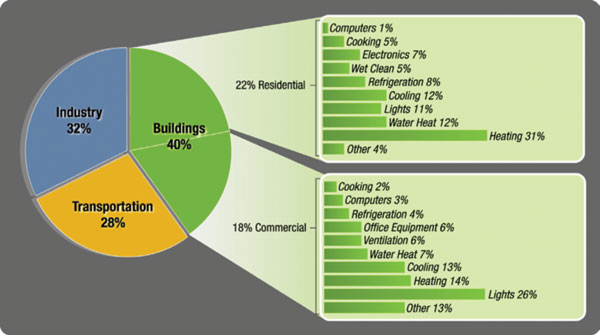The Future of Shade
The Evolution of Shading Fabrics
Prior to the 1960s, most awnings and shading fabrics were made of cotton canvas, which the sun broke down quickly. In 1961, the owners of one of the oldest, most respected fabric brands decided to change the nature of shading materials the company had been making since the 1880s. They replaced cotton with acrylic fibers and pre-extrusion pigments and offered an unheard-of warranty of five years. They were dubbed “performance fabrics.”
In the 1970s, performance fabrics got the attention of boaters, and the outdoor furnishings industry exploded with these new, long-lasting yet pliable fabrics. In 1988, BMW became the first car brand to adopt this company's fabrics for its convertible models.

Photo courtesy of Sunbrella
The use of shading fabric as a branding strategy spans history.
By the early 2000s, as the green building movement gained momentum with the U.S. Green Building Council's LEED rating program, more attention was paid to the sustainable nature of performance fabrics. As high-performing shade fabrics last longer, people use less fabric and thus generate less waste as compared to other fabrics that might fade, lose strength, or give in to mildew and atmospheric chemicals. In fact, some fabrics can be recycled through manufacturer recycling programs, reducing impact on landfills. This is in addition to the energy benefits of building shading that will be discussed later in the course.
The cleanability of outdoor shading fabrics is among the latest topics to interest industry and end users alike. Because of the sturdy makeup of high-performance shading fabrics, they can be cleaned with a variety of common cleaning products, such as dishwashing liquid, vinegar, ammonia, acetone, paint remover, turpentine, and even bleach. (See manufacturer's recommendations for specific amounts and mixtures.) Of course, brushing off dirt and dust at regular intervals is a good deterrent to staining. While advanced shading fabrics do not promote mildew growth, mildew may grow on dirt and other foreign substances that are not removed from the fabric. Some manufacturers recommend specific spray-on fabric-guard products to strengthen or restore a fabric's water repellency.
Signage and Branding with Fabrics
As the use of shading fabric continues its trajectory in modern architecture, its use as a business branding strategy spans the decades. Historically, a print canvas canopy over a cigar shop or beauty parlor signaled the establishment's presence to passersby.
While that design practice continues today, modern corporate branding with fabric is often spectacular, with enormous printed banners moving in the breeze. They are a signal to passersby and even passing aircraft that business or cultural events are happening there. The colors of the shading fabric convey their own branding message, tying into the corporate, company, educational, or non-profit organization's identity.
Expanding Space
Shading strategies in corporate, cultural, and residential settings create copious amounts of added space for meetings, gatherings, meals, and leisure. While the cost of walls and a roof could be prohibitive, and most likely exceeding a particular lot's allowable square footage of structure, the addition of shaded “rooms” becomes a possible way to expand the amount of usable space. Fabric enclosures in commercial spaces such as restaurants can help boost profits by increasing the amount of outdoor seating available year round.
Although the early history of awnings and shade structures was driven by many factors—business branding, shelter from rain and sun, expanding space—only recently has sun protection taken on dire significance concerning skin cancer prevention. That and other less deadly but equally impactful consequences of the sun/shade paradigm will be discussed next.
Shade Structures for Personal Health and UV Protection
Why is shade important to humanity?
In iconic portrayals of early humans struggling to survive harsh environments, shade of some sort will likely be depicted: from caves to animal-skin tents to families on the savanna huddled beneath the shade of a tree. Protection from the sun has always been important to humanity, but never so much as it is in modern times, with holes in the ozone layer and the unprecedented speed at which our planet is warming. Whereas natural climate change occurs gradually, giving organisms the opportunity to evolve their own protections, the speed of this man-induced climate change requires man-made protections.
There are, of course, positive and negative aspects of sunlight. Photosynthesis, which transforms minerals and water into plant matter, relies on sunlight, and we rely on the food produced by sunlight. The very fuels we dig increasingly deeper to harvest, originated from microscopic plants and animals absorbing energy from the sun, which was stored as carbon molecules and later as oil or gas. In some countries, the sun is increasingly harnessed to create solar power.
Even for humans, sunlight is a powerful mood boost, as is attested by the increase of SAD (seasonal affective disorder) sufferers during wintertime or in areas where days are shortened. It gives us light during daytime hours, which makes life easier and more energy efficient. It even prompts the human body to produce vitamins, especially D.
Ideally, we don't want sunlight to be totally “on” or “off,” and that is where UV-resistant shading fabric (as well as shade itself) comes into play.
Rising skin cancer rates are one of the biggest negatives for sun exposure. According to the Skin Cancer Foundation:
• Skin cancer is the most common form of cancer in the United States; more than 3.5 million skin cancers in over two million people are diagnosed annually.
• Each year there are more new cases of skin cancer than the combined incidence of cancers of the breast, prostate, lung, and colon.
• Treatment of nonmelanoma skin cancers increased by nearly 77 percent between 1992 and 2006.
• Over the past three decades, more people have had skin cancer than all other cancers combined.
• One in five Americans will develop skin cancer in the course of a lifetime1.
“Almost all of the conditions were caused by unnecessary ultraviolet (UV) radiation exposure,” stated Howard K. Koh of the U.S. Department of Health and Human Services. “As a nation, we can all do more to address skin cancer as a serious public health challenge.”2
The Acting U.S. Surgeon General, Dr. Boris D. Lushniak, a dermatologist, recently released a “Call to Action to Prevent Skin Cancer.”3 In the report, he repeatedly includes seeking shade as a known method of preventing skin cancer. This is particularly needed in areas where children play, including pool environments. Providing shade in pool environments is encouraged by “Pool Cool Program,” a research program from the University of Pennsylvania.4
And the Skin Cancer Foundation recommends fabric awning as well as marine and upholstery fabrics in shading products to help in the prevention of sun-induced damage to the skin as part of a complete sun protection regimen, including regular use of sunscreen.
As the Pool Cool Program points out, changing behaviors that cause us to seek shade are beneficial for human health. Increases in shading strategies and structures are also good for the health of the planet and the comfort levels of humans in buildings.
Textiles in Shade Structures for Thermal Performance and Energy Efficiency
Many factors drive the need for shade structures.
Demographics show that more and more people are living in sunny and hot locations. In the United States, according to census data, population growth in southern and western states, which is led by Florida, Texas, and California, accounted for more than 80 percent of new residents in the past few years.
“That requires a lot of air conditioning,” notes Bernstein.
In these southern states and others, unfettered daylight entering a building brings with it several serious challenges:
• Glare, which causes stress and strain on the occupants
• Solar heat gain, which drives up energy use
• Ever changing nature, which is difficult for solid structures to ameliorate
• UV rays, which cause health problems and fade furnishings
On the upside, controlled natural light entering a building potentially saves energy and operating costs.
According to the U.S. Dept. of Energy, buildings account for about 40 percent of total U.S. energy consumption (costing $350 billion per year) and greenhouse emissions.5 Commercial buildings use 18 percent of all energy, and lighting accounts for 26 percent of that, using the same amount of energy as heating and cooling combined.

Image courtesy of U.S. Department of Energy
Decreasing the need for artificial lighting and unwanted solar gain, while increasing the opportunity for wanted solar gain, are made possible by exterior shading strategies.
A number of high-profile projects use flexible, movable exterior shading strategies to achieve these goals—to counteract the deleterious effects of sunlight and to harvest that sunlight as conditions indicate. These are known as “dynamic facades.”
Well-known dynamic facade projects are located in Chicago (Loyola University), Singapore (Gardens by the Bay), Tokyo (Sony), and other places.
Exterior shading devices will likely continue their upward trajectory and certainly appeal to architects' drive to combine form and function, particularly high-performing, energy-efficient functionality.
This is clear to Bernstein, the architecture writer and critic.
“Shade structures made of textiles can block sunlight and therefore reduce the heat gain inside a building, which then reduces the amount of air conditioning that's required. So, that's environmentally responsible. Also, shade structures can encourage people to spend more time outside. And if people are spending more time outside, they're spending less time inside in air-conditioned, enclosed spaces, so that's environmentally responsible.”
Inside, automated roller blinds perform a similar function, blocking heat, cutting down on glare and occupant discomfort, and preventing UV damage to furnishings.
Rather than considering shading fabrics as cosmetics or furnishings, they are increasingly built into energy-saving strategies and factored into energy analysis and modeling to optimize solar shading performance. In small and large buildings, active and passive shading strategies are being incorporated into energy analyses along with radiant slabs, chilled beams, geo-exchange systems, and other mainstream and emerging energy and daylighting approaches.









